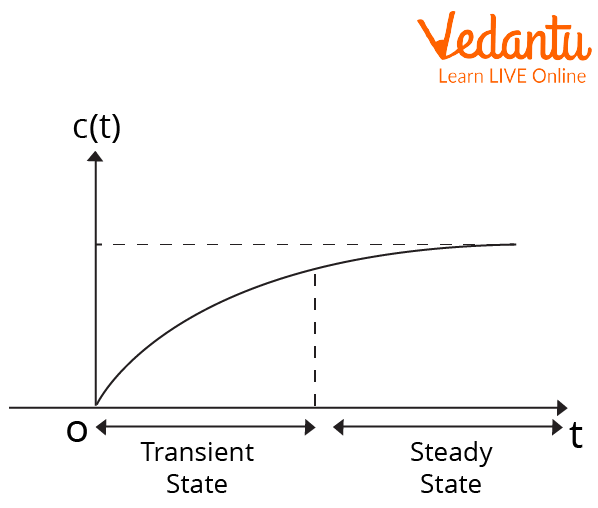




A Brief Introduction to the Final Value Theorem
The Final Value Theorem is a fundamental tool in a circuit system working. It is based on Laplace functions and their transformation. So, to understand the final theorem, we need to have some idea about Laplace transformations. In this article, we will be discussing the final value theorem in depth. We will also discuss the application of the final value theorem in circuit systems and how problems related to the theorem can be solved will also be discussed in this article. Below is the figure which shows the state for a function:

Steady-state Function
History of Pierre-Simon Laplace

Pierre-Simon Laplace
Name: Pierre-Simon Laplace
Born: 23 March 1749
Died: 5 March 1827
Field: Mathematics
Nationality: French
Statement of the Final Value Theorem
The final value theorem states that if $x$ is any function of $t$ and Laplace transformation of $x$ is denoted as X(s), i.e., \[x(t) \underrightarrow{L T} X(s)\]
then,
$\mathop{\lim}\limits_{t \rightarrow \infty}x(t)=x(\infty)=\mathop{\lim}\limits_{s \rightarrow 0}sX(s)$
Here, LT represents Laplace Transformation.
Proof of the Final Value Theorem
From the definition of the unilateral Laplace transform, we have
$L[x(t)]=X(s)=\int_{0}^{\infty} x(t) e^{-s t} d t$
Taking differentiation with respect to time on both sides, we get $L\left[\dfrac{d x(t)}{d t}\right]=\int_{0}^{\infty} \dfrac{d x(t)}{d t} e^{-s t} d t$
Now, by the time differentiation property, i.e., $\dfrac{d x(t)}{d t} \underrightarrow{L T}\:s X(s)-x\left(0^{-}\right)$ of Laplace transform, we have
$L\left[\dfrac{d x(t)}{d t}\right]=\int_{0}^{\infty} \dfrac{d x(t)}{d t} e^{-s t} d t=s X(s)-x\left(0^{-}\right)$
By taking the $\mathop{\lim}\limits_{s \rightarrow 0}$ on both sides of the above expression, we get
$\mathop{\lim}\limits_{s\to0}[\int_{0}^{\infty}\dfrac{\text{d}x(t)}{\text{d}t}e^{-st}dt]=\mathop {\lim }\limits_{s \to0}[sX(s)-x(0^{-})]$
$\Rightarrow \int_{0}^{\infty} \dfrac{d x(t)}{d t} d t=\mathop{\lim}\limits _{s \rightarrow 0}\left[s X(s)-x\left(0^{-}\right)\right]$
$\Rightarrow[x(t)]_{0}^{\infty}=\mathop{\lim}\limits _{s \rightarrow 0}\left[s X(s)-x\left(0^{-}\right)\right]$
$\Rightarrow x(\infty)-x\left(0^{-}\right)=\mathop{\lim}\limits_{s \rightarrow 0}\left[s X(s)-x\left(0^{-}\right)\right]$
$\Rightarrow x(\infty)=\mathop{\lim}\limits_{s \rightarrow 0} s X(s)$
Therefore, we have
$\mathop{\lim}\limits_{t \rightarrow \infty} x(t)=x(\infty)=\mathop{\lim}\limits_{s \rightarrow 0} s X(s)$
Limitations of the Final Value Theorem
The Final Value theorem does not apply when the Laplace transform has imaginary but non-zero poles as the limit of time response does not exist.
The Final Value theorem does not apply when the pole is in the right half plane.
Applications of the Final Value Theorem
The Final Value theorem has wide application in electronic devices or circuits.
The Final Value theorem is used to find the steady or transient state of a function.
The Final Value theorem is used to find the transient state gain of a wash-out function.
Solved Examples
1. What is the steady state value of f(t), if it is known that $F(s)=\dfrac{2}{s(s+1)(s+2)(s+3)}$.
Ans: From the equation of $F(s)$, we can infer that a simple pole is at the origin and all other poles are having negative real parts.
$\therefore f(\infty)=\mathop{\lim}\limits_{s \rightarrow 0} s F(s) $
$\Rightarrow f(\infty)=\mathop{\lim}\limits_{s \rightarrow 0} \dfrac{2 s}{s(s+1)(s+2)(s+3)} $
$\Rightarrow f(\infty)=\dfrac{2}{(s+1)(s+2)(s+3)} $
$\Rightarrow f(\infty)=\dfrac{2}{6} $
$\Rightarrow f(\infty)=\dfrac{1}{3}$
2. What will be the inverse Laplace transform of \[F(s)=\dfrac{2}{s^{2}+3 s+2}\]?
Ans: $s^{2}+3 s+2=(s+2)(s+1)$
Now, $F(s)=\dfrac{A}{(s+2)}+\dfrac{B}{(s+1)}$
Hence, $A=\left.(s+2) F(s)\right|_{s=-2}$
$\Rightarrow A=\left.\dfrac{2}{s+1}\right|_{s=-2}$
$\Rightarrow A=-2$
And, $B=\left.(s+1) F(s)\right|_{s=-1}$
$\Rightarrow B=\left.\dfrac{2}{s+2}\right|_{s=-1}$
$\Rightarrow B=2\\$
$\therefore F(s)=\dfrac{-2}{(s+2)}+\dfrac{2}{(s+1)} $
$\therefore F(t)=L^{-1}\{F(s)\} $
$\Rightarrow F(t)=-2 e^{-2 t}+2 e^{-t} \text { for } t \geq 0$
3. What will be the inverse Laplace transform of $F(s)=\dfrac{2}{s+c} e^{-b s}$?
Ans: $\text { Let } G(s)=\dfrac{2}{s+c} $
$\text { Or, } G(t)=L^{-1}\{G(s)\} $
$\Rightarrow G(t)=2 e^{-c} $
$\therefore F(t)=L^{-1}\left\{G(s) e^{-b s}\right\} $
$\Rightarrow F(t)=2 e^{-k(t-b)} u(t-b)$
Important Formulas to Remember
If $x(t)\:\underrightarrow{L T}\:X(s)$,
Then $\mathop{\lim}\limits_{t \rightarrow \infty} x(t)=x(\infty)=\mathop{\lim}\limits_{s \rightarrow 0} s X(s)$
Laplace transformation: $L[f(t)]=F(s)=\int_{0}^{\infty} f(t) e^{-s t} d t$
Important Points to Remember
Laplace transformation is an essential tool to learn the final value theorem.
Circuit Diagrams and electric circuits are based on the application of the final value theorem.
Conclusion
The Final Value Theorem has a wide range of applications in daily life and it is a fundamental tool for functional analysis and electrical circuits. In the above article, we have discussed the Final Value theorem in brief, and the limitations of the theorem are also discussed. So, in short, we can say that the Final Value theorem forms a vital component of our life and makes our day-to-day work easy.
FAQs on Final Value Theorem of Laplace Transform
1. What is Laplace Transform?
Consider the function $f(t)$, which is a piecewise continuous function, then $f(t)$ is defined using the Laplace transform. The Laplace transform of a function is represented by $L\{f(t)\}$ or $F(s)$. Mathematically, we can represent it as :
$L[f(t)]=F(s)=\int_{0}^{\infty} f(t) e^{-s t} d t$
The inverse of any Laplace transformation can also be calculated. The final value theorem is based on Laplace and inverse Laplace transformations. Laplace transformations form the basis of Circuit systems and the theorem discussed in the article is an extended version of Laplace transformations applications.
2. What is the initial value theorem and how is it different from the final value theorem?
Initial Value Theorem determines the value of the time function when t=0 without finding the inverse transform.
Procedure:
Find the transfer function X(s).
Multiply X(s) by s.
Take the limit of sX(s) as s goes to infinity.
Result is value of x(t) when t = 0.
Both theorems determine the value of a function without finding the inverse transform. However, the initial value theorem finds the value of the system at time=0, i.e, at the initial state while the final value theorem is used to find the steady state of the system, i.e., at time = infinity.
3. For the application of the Final Value theorem, the pole should lie on which side of the plane?
The pole should lie on the left half of the s-plane for the application of the Final value theorem. As, if poles don’t lie on the left half of the s-plane, the system is not stable. An unstable system yields an erroneous final value, i.e., an erroneous steady-state response. They also cannot lie on the imaginary axis. Hence, the theorem is applicable only in the case of poles lying on the left half of the s plane. So, we can also say that the final value theorem is only applicable for unstable systems and not in the case of stable or marginally stable systems.
























